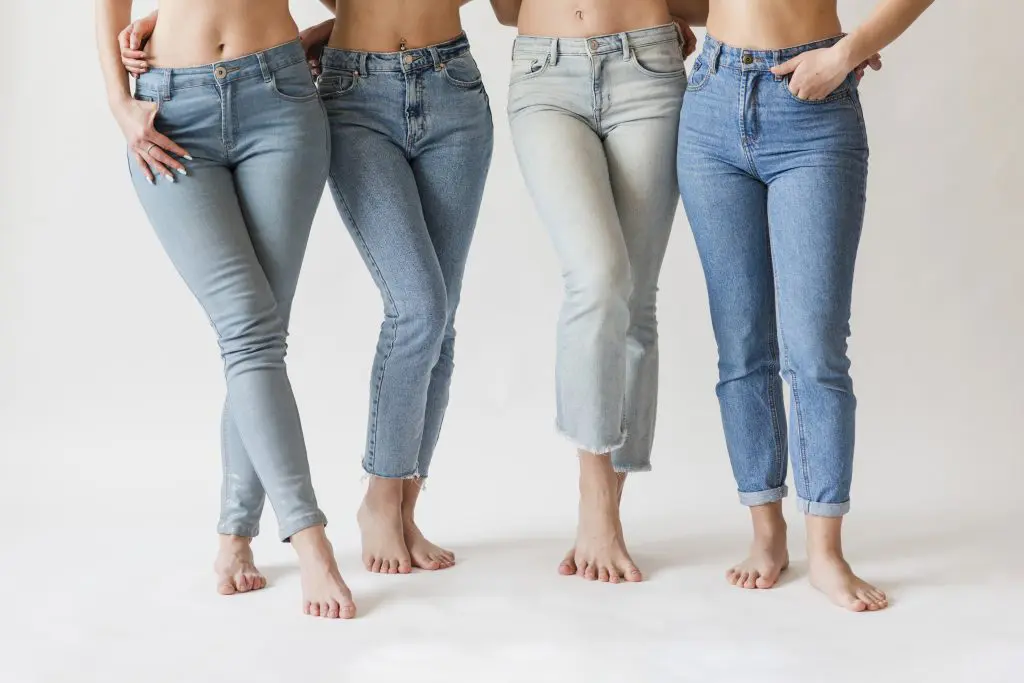Summary
- A good denim pattern is essential for people to feel comfortable when wearing their clothes.
- A well-executed pattern enhances the silhouette, highlights body features and even creates favorable optical illusion.
- Try virtually making patterns for your next collection for free with Audaces360 multisolution!
Jeans are a very versatile item and are popular all over the world. At least one denim piece should be part of anyone’s wardrobe.
A high-quality denim clothing must start with excellent pattern making – it makes all the difference when wearing it.
Learn about denim patterns and how to make it in the best way in your clothing company.
Enjoy your reading!
Sumário
What is the importance of good denim patterns for clothing companies?
A good denim pattern ensures the jeans will adjust correctly to the body, providing a good fit and comfort to who wears it. This is essential for people to feel good when wearing it and to encourage repeat purchases.
In addition, proper pattern making influences the appearance of the jeans. It defines the shape of the legs, the positioning of pockets, the height of the waistband and other details that can highlight or hide some parts of the body.
Well-made patterns can enhance the silhouette, highlight the best body features and even create favorable optical illusion.
By creating consistent and standardized patterns, clothing companies ensure that each denim piece has the same measurements and proportions. This is essential for maintaining product quality and uniformity, streamlining large-scale production, and avoiding rework.
Excellent patterns can optimize the use of materials, minimizing waste during the cutting process and increasing production efficiency.
Learn more: Understand the importance of a pattern maker for fashion manufacturing
How does denim pattern making happen?
Denim pattern making involves a series of steps and techniques. Let’s take a look at the process:
Fundamentals of denim patterns
It is essential to understand the characteristics of denim fabric, such as elasticity, weight, stiffness, among others. They will influence the choice of models and adjustments to be made.
Anatomy and basic adjustments in denim patterns
It is important to know how to position the waistband, considering the desired height and body curvature.
The adjustment of the crotch is also crucial to ensure comfort and avoid excess fabric or uncomfortable tightness.
The denim pattern should also take into account the width and shape of the hips and thighs to ensure the best fit, avoiding the jeans from being too tight or too loose in these areas.
Learn more: Explore clothing pattern making techniques for your production
Main measurements and proportions to consider
There are several body measurements that are extremely important when creating a denim clothing, such as:
- Waist: measurement around the narrowest part of the torso
- Hips: measurement around the widest part of the hip
- Crotch length: measurement from waist to center of body and from center of body to back waist
- Leg length: measurement from the waist to the desired length
Learn more: Check out 8 advantages of the clothing measurements chart for the fashion business
Use of pattern block and specific adaptations for denim
Pattern blocks are usually developed for trousers made from non-stretch fabrics. From these, adaptations are made for denim fabric, such as adjustments to accommodate the material’s elasticity.
Advanced denim pattern making techniques

Just like cuts and pattern blocks, there are techniques to make your garment look even better and with the best fit.
Denim pattern making for stretch fabrics requires special adjustments to ensure the necessary flexibility. Darts and pleats, for example, can be used to better accommodate extra volumes or create specific effects.
Effects and details in pocket pattern making
Pockets should be positioned according to the anatomy and proportions of the body, considering the correct height, width and angle.
When it comes to shape and sewing, it is possible to create visual and design effects, like pockets with curves, embroidery, or decorative topstitching.
Learn more: 6 types of pattern making courses to enhance your skills in fashion industry
Seams and rivets to reinforce the structure
Seams in denim fabrics are usually reinforced to ensure the clothing’s durability, especially in areas of high tension, such as the crotch and inseams.
Meanwhile, rivets are used to reinforce joints and other points of high tension, like pockets and belt loops.
Pattern making for different types of jeans cuts
A denim pattern varies according to the desired cut. It can change depending on the brand, target audience, and specific design preferences.
Skinny
This type of cut is designed to be tight-fitting to the body. It is made to fit closely to the wearer’s legs, accentuating the silhouette.
Additionally, its fabric is stretchable or has some elasticity to allow a tight fit to the body.
Bootcut
Bootcut jeans are fitted at the thighs and slightly wider from the knees to the hem. They are designed to accommodate boots beneath the jeans, hence the name “bootcut”.
One of its features is having enough length to cover the boots, but not so long as to drag on the ground.
Straight
Straight jeans have straight and uniform cut, without widening or tapering in the legs. It’s considered a classic and versatile style.
Jeans with washed and distressed effects

Denim clothing with washed and distressed effects are popular and add a unique style to the final product.
There are several types of washes, here are some:
Acid washing
This process consists in washing the jeans with acidic chemicals to corrode and bleach the fabric. The result is an aged and worn-out appearance.
Stone washing
In this method, the jeans are washed with stones (pumice stones) to soften the fabric and achieve a distressed appearance.
The fabric comes in contact with the stones during washing, causing fading in specific areas by the rubbing action.
Bleach washing
This technique uses bleach-based chemicals applied to the denim to remove color and create a faded effect.
Bleach is applied in limited amounts in specific areas to create a distressed or spotted pattern.
Manually distressing
In this process, the distressed effect is created manually using tools such as sandpaper, hard bristle brushes, and knives.
Laser
Widely used, laser technology creates distressing effects on denim garments. The laser used to selectively bleach the fabric produces patterns and creates custom designs.
What are the advantages of digital denim pattern making?
Digital denim pattern making offers several advantages compared to traditional patterns, made manually.
Some of these benefits include:
Precision and consistency
Digital pattern making allows greater precision in measurements and proportions, resulting in a better fit of denim clothing.
Furthermore, digital pattern making enables consistent replications of adjustments in different sizes and designs, ensuring standardization.
Agility and efficiency
Digital pattern making speeds up the development of denim garments by eliminating the necessity of creating paper patterns.
Adjustments can be made quickly and easily in pattern making software, reducing production time and enabling a more agile answer to market demands.
Cost reduction

Digital pattern making reduces costs associated with creations and maintenance of paper patterns.
It’s no longer necessary to produce a sample garment for every design change, as you can visualize and make adjustments digitally.
Moreover, digital patterns help optimize fabric consumption, reducing waste and production costs.
Learn more: Learn more about fabric yield and avoid waste in your production
Facilitated collaboration and communication
With digital patterns, it’s easy to share files and projects, with design and productions teams, and suppliers.
It streamlines communication, preventing errors and misunderstandings in the transfer of information between the parties involved in the process.
Simulation and visualization
Digital modelling enables virtual simulation of the fit of denim garments, allowing a more realistic visualization and a preliminary assessment of the final result.
It helps anticipate potential fit issues and make adjustments before production.
Sustainability
Digital modelling and pattern making contribute to the reduction of paper and physical materials use, making the process more sustainable and ecological.
Furthermore, optimizing fabric consumption reduces waste, minimizing environmental impact.
Learn more: Why consider sustainable consumption and production for your company?
Create denim patterns 100% digitally with Audaces

If you want to create your denim clothing with error-free patterns, Audaces offers cutting-edge technology solutions to help:
Audaces360
Audaces360 is a multi-solution that integrates the creative and production stages, resulting in more accuracy and profitability for your clothing manufacturing.
Its key features are:
- Systemic view of production process
- Complementary tools
- Reliable and real-time information
- Quick and efficient decision-making
- Production agility
- Possibility to customize orders
- Diversification of offers
- Work with reduced stock
- And much more!
Audaces Pattern
Audaces Pattern offers a simple and intuitive interface that streamlines the production of your collections.
With fast and efficient technology, the creation of digital patterns is 70% faster than manual processes.
In addition, the system provides automatic measurement charts, which facilitate the creation of complex patterns, streamline grading, and eliminate the use of paper.
All of this makes the technology profitable and a great ally in clothing production
Audaces 3D
With Audaces 3D, pattern makers can create digital prototypes of clothing in 3D, simulating how the garments would look on different body types.
One of the numerous advantages of Audaces 3D is its integration with Audaces Pattern, optimizing the entire process, from the initial idea to large-scale production.
As a result, it’s possible to reduce development time and ensure greater production accuracy.
Learn how digital modelling works in Audaces system and create patterns with more convenience! Download our e-book for free:
FAQ
A good denim pattern ensures the jeans will adjust correctly to the body, providing a good fit and comfort to who wears it.
Fundamentals of denim patterns, anatomy and basic adjustments, main measurements and proportions, use of pattern block and adaptations, advanced techniques, and details in pockets, seams, and rivets.
Acid washing, stone washing, bleach washing, manually distressing and laser.










